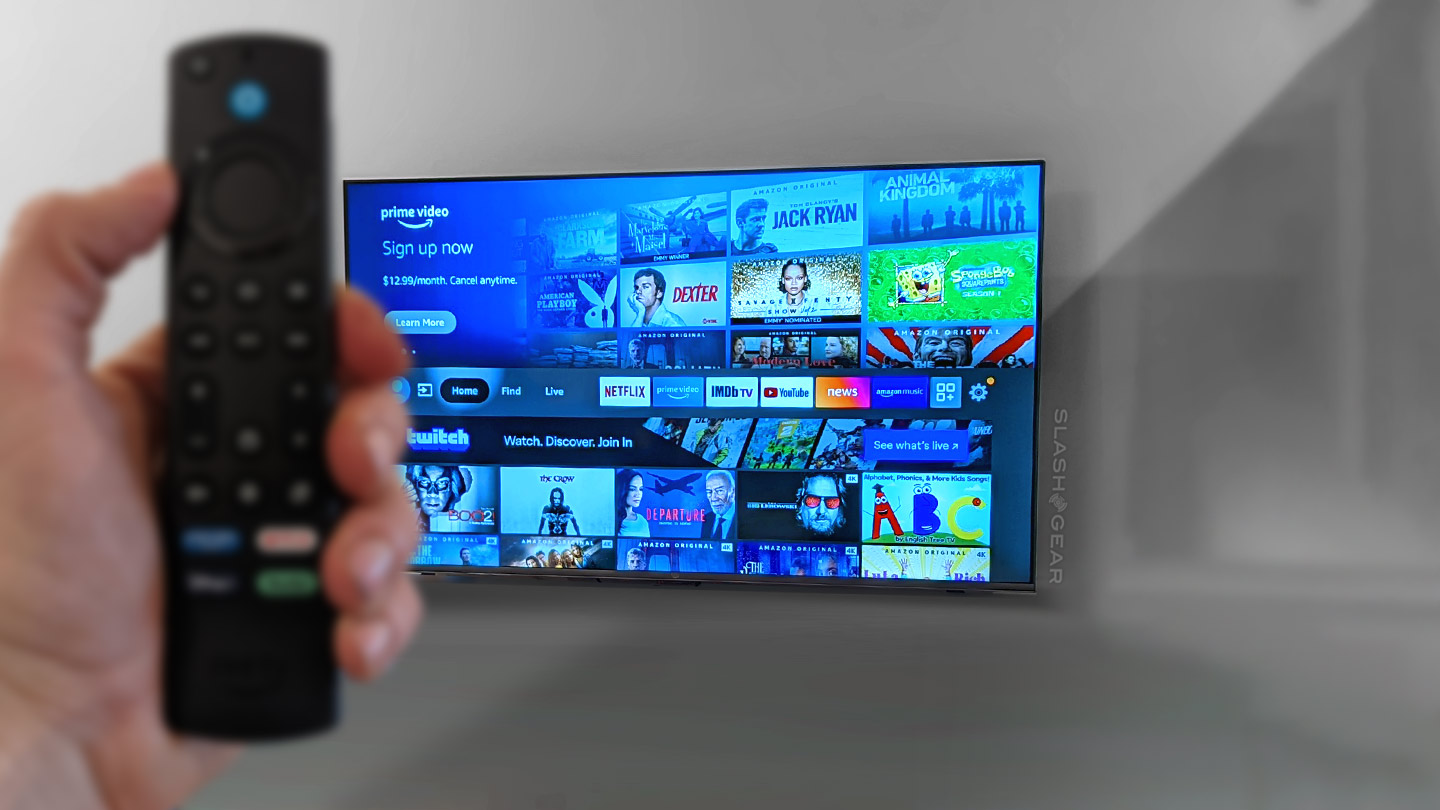
Amazon has been dabbling in the smart TV market for a few years now, allowing TV manufacturers to use the same software that drives some of the best streaming devices, such as the Fire TV Stick 4K Max and Fire TV Cube, to power low-cost smart TVs. However, the Amazon Fire TV Omni series represents a significant departure from that approach, since it is the first Amazon-powered smart TV to bear the Amazon brand rather than that of another manufacturer, as well as the first of what will undoubtedly be many Fire TV models to include built-in far-field microphones for hands-free voice control.
The Amazon Fire TV Omni series takes this to a new level, increasing built-in Alexa capabilities and marrying it with a better-looking TV than any other Fire TV we’ve seen. Our Amazon Fire TV Omni review delves into the numerous ways Amazon strives to make their latest Fire TV the greatest Fire TV on the market.
Table of Contents
Price and release date for Amazon Fire TV Omni
This year, Amazon launched two new Fire TV models under the Amazon brand: the Omni and the 4-Series Fire TV. The Omni is the more costly of the two, having a more upscale look and built-in features (such as hands-free Alexa) that the 4-Series lacks.
The 65-inch Fire TV Omni, which retails for $829 on Amazon and Best Buy, was the subject of our evaluation.
- 43-inch (B08T6DZ81T) – $409
- 50-inch (B08T6F8YBH) – $509.99
- 55-inch (B08P3QVFMK) – $559.99
- 65-inch (B08T6J1HG8) – $829.99
- 75-inch (B08T6JZTH4) – $1,099.99
The majority of the characteristics are consistent across all model sizes. The Fire TV software is identical to that of previous Fire TVs, but the TV has additional hardware to handle features such as hands-free Alexa control.
The inclusion of Dolby Vision HDR content, which is only available on the 65 and 75-inch models, is the only notable difference between the three screen sizes. Because none of the Amazon Fire TV Omni models allow local dimming, this format support is restricted.
Our overall observations of the 65-inch model we tested should apply to any screen size in the Omni model range, with the caveat that not all models include Dolby Vision.
Review of the Amazon Fire TV Omni: Design
The new Amazon Fire TV Omni series is, by far, the best-looking Fire TV yet. The design is an improvement over prior Fire TV models, with a more streamlined chassis and silver-toned accents that look significantly nicer than the boxy black plastic used on earlier Fire TV models. Much thinner bezels, metal trim, and robust metal feet distinguish this device as considerably more expensive.
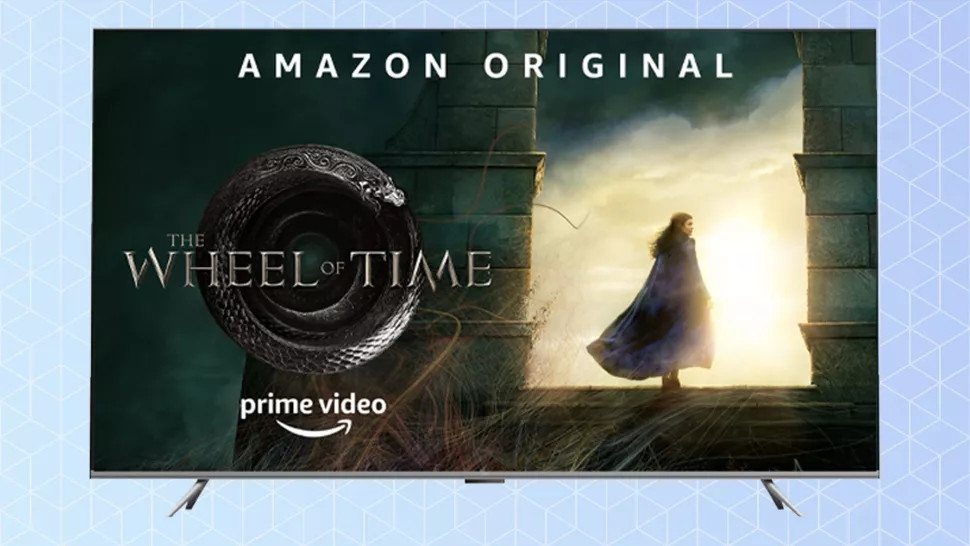
The rear of the chassis is basic matte black plastic, as expected, but instead of the customary boxy form preferred by many low-cost TVs, Omni adopts a sleeker approach, with rounded corners and gently tapering edges. We’ve gone a long way from the 2017 Westinghouse Amazon Fire TV, with its plastic structure and hefty style.
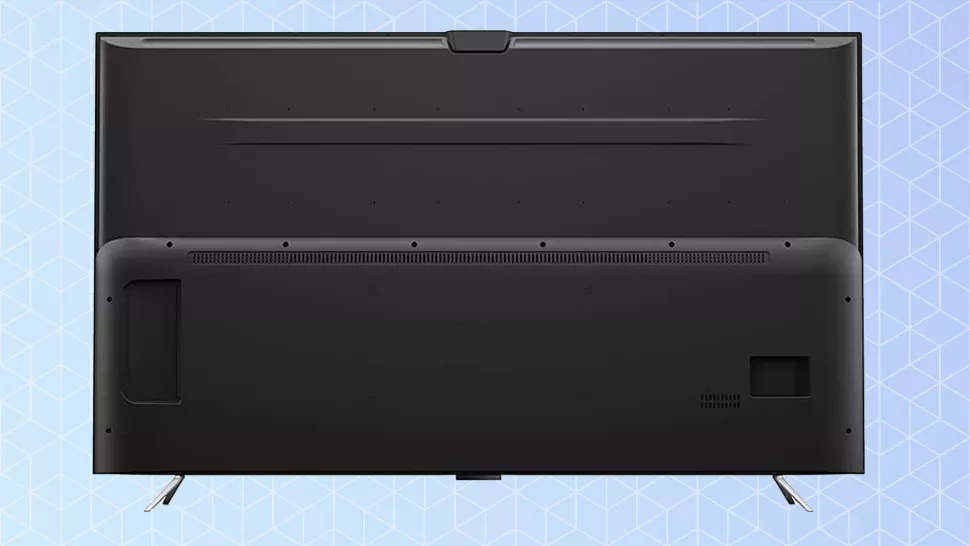
It may be readily erected and installed by two persons, measuring 57.1 × 33.3 x 2.9 inches and weighing 42.5 pounds. The TV will take any 400-millimetre x 200 millimeter VESA hardware, including those included on our list of the best TV mounts if you choose to put it on the wall.
The majority of the other features will be discussed elsewhere in this review, but one, in particular, stood out for its design and functionality. A small bar right below the display contains a hardware switch that disables the TV’s built-in far-field microphones, which are used for room-listening Alexa interaction. The switch is simple to use and swap back and forth, but it’s a bit difficult to determine which is on and which is off. Thankfully, there’s also a visible LED signal that turns red when the microphones are turned off.
Review of the Amazon Fire TV Omni: Ports
The Omni series includes three HDMI 2.0 ports and one HDMI 2.1 port with eARC. A single USB port and an Ethernet port supplement the built-in 802.11ac Wi-Fi. A coaxial connector for the antenna and cable, a 3.5-millimetre audio port for speakers or headphones, and an optical digital audio output for connecting older sound equipment are also included on the TV.
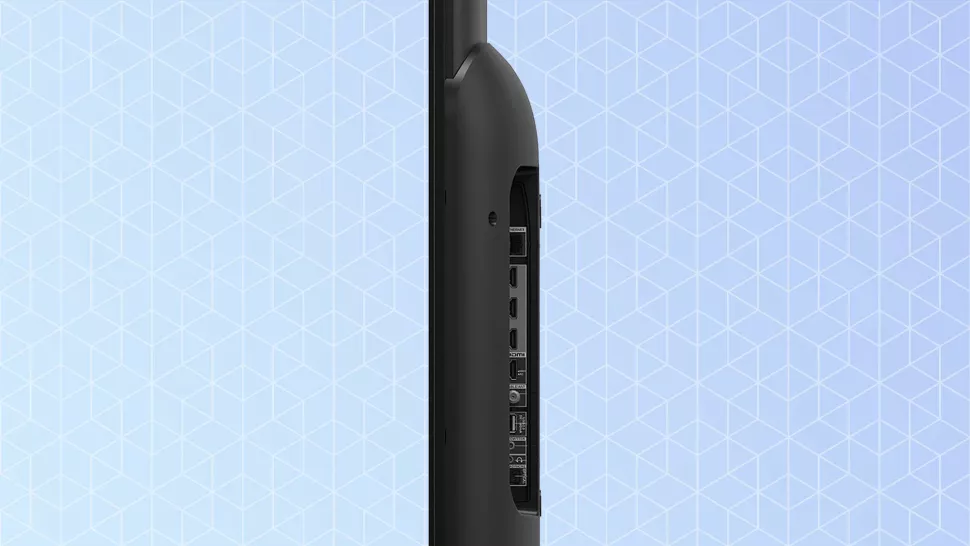
There’s also a connector for the infrared emitter that comes with the kit. This unique feature allows you to use the TV’s built-in Alexa skills to manage other devices in your home entertainment setup, with the TV using the IR emitter to run any gear that would normally require a traditional remote control. It’s akin to some of the greatest universal remotes in various areas.
Amazon Fire TV Omni Review: How Does It Perform?
The Fire TV Omni’s major selling point is its performance. The 65-inch screen is larger than other Fire TVs and supports HDR10 and Dolby Vision. Given Omni’s greater pricing and more attractive design, it’s natural to expect it to outperform rival Fire-powered smart TVs.

Regrettably, this was just partially correct. During my time with the TV, I couldn’t help but believe that the set’s simple LCD display and direct LED lighting were holding it back.
While watching The Tomorrow War, Chris Pratt’s time-displaced soldier looked terrific in action moments, with strong motion management minimizing most of the noticeable judder or smearing that you may see on a lower-quality set. The 4K screen did a good job with clarity and colour, and the CGI aliens are nicely depicted in all their toothy magnificence.
HDR material has an excellent contrast between dark and bright areas, while certain dark scenes lose clarity in shady areas. One scene set within a dark alien spacecraft was an excellent demonstration of the TV’s HDR capabilities. Handheld flashlights blazed brightly as they swept across the dark, alien ship interiors, and HDR managed to keep the flashlight beams illuminated without sacrificing the depth of the deeper scene. It wasn’t perfect, since the image’s black portions occasionally lost clarity in a smattering of undifferentiated darks, but it was as good as direct LED backlighting without any specified dimming zones can be.
When viewed through single-colour test displays, the Omni showed very good viewing angles, with just modest colour shifts beyond 45 degrees from the center. The tones are still discernible, albeit a little washed out, but the material should be visible even from extreme angles.
Colour was also handled fairly well by the television. While viewing moments from CGI-animated children’s shows like Lost in Oz, the dazzling palette of colours felt colourful and diversified. The colour reproduction appeared to be good to the unaided eye, with the exception of reds and pinks, which appeared to be oversaturated. The contrast is a little low, and the brightness may be improved, but the overall impression is inconspicuous.
The transition from game to game mode was straightforward and fluid. During my playtesting with Assassin’s Creed Valhalla, I was thrilled to observe good colour fidelity in everything from sundrenched Viking towns to abstracted glowing interfaces, and HDR content appeared to show properly with a nice balance of brilliant glow and deep shadows.
Test results for Amazon Fire TV Omni
Our lab testing revealed the good and bad of the Fire TV Omni, and while the TV isn’t horrible to look at, it’s not the best you can buy for the money. It’s (mostly) a step up over our previous favourite Amazon smart TV, the Toshiba C350 Fire TV, owing to hands-free control and a slick new design, but it’s a closer match than it really should be considering the almost $300 price difference between the two. And, when compared to competitors like the Vizio M-Series Quantum MQ6 and the TCL 5-Series Roku TV (S535), Amazon’s initial Fire TV clearly has room for development.
The Amazon Omni’s colour gamut was inadequate, matching only 96 per cent of the Rec 709 colour palette. While this is an improvement over the Toshiba C350 Fire TV’s (95 per cent) rating, it still falls short of the TCL 5-Series Roku TV’s (99.8 per cent) and Vizio M-Series Quantum MQ6’s (99.8 per cent) (99.9 per cent). (99.96% of the time). It’s also worth noting that these less costly competitors provide something Omni lacks: QLED. Although quantum dot enhancement improves colour and brightness and has nearly become a standard feature in this price range, the Fire TV line lacks QLED options.
The results of colour accuracy testing were comparable. The Omni’s Delta-E average of 4.4 isn’t fantastic (closer to zero is preferable), but it’s more prevalent among the low-cost versions that Fire TV normally runs on. However, when compared to the competition, it’s another flaw in Omni’s favour. The TCL 5-Series Roku TV (1.76) and the Vizio MQ6 (1.68) are both superb out-of-the-box performers, and even the Toshiba C350 Fire TV outperformed both (1.67).

One area where the Omni held its own was in terms of brightness. With a measured peak brightness of 494 nits, it outperformed both QLED competitors like the TCL 5-Series (391 nits) and the Vizio M-Series MQ6 (299 nits), as well as the previous top Fire TV, the Toshiba C350 (227 nits).
Gaming was a different story. When tested with a 4K Leo Bodnar signal lag tester, the Omni recorded a latency time of 9.8 milliseconds. That’s a fantastic result, and it ranks with the Vizio M-Series Quantum MQ6 (10ms) and the Toshiba C350 Fire TV (9.7ms).
Review of the Amazon Fire TV Omni: Audio
The audio on Amazon’s top-of-the-line Fire TV, the Omni, is disappointingly basic. With a pair of 8-watt speakers delivering stereo sound, the TV offers reasonably loud volume levels, but when set to the settings that are likely to be used for casual TV watching, the TV issues with bass — bass comes through nicely around 20 per cent loudness, but any quieter and the low-end fades out completely, throwing off the mix.
Whether we were watching Michael B. Jordan’s Without Remorse or the wild country of Oz in Lost in Oz, the Omni provided acceptable clarity of dialogue and sound effects. At mid-range settings (between 30 and 60%), the TV produces a nice balance of bass and treble and even manages to avoid some of the distortions we typically hear at higher volumes. The stereo speakers provide good right/left separation as well.
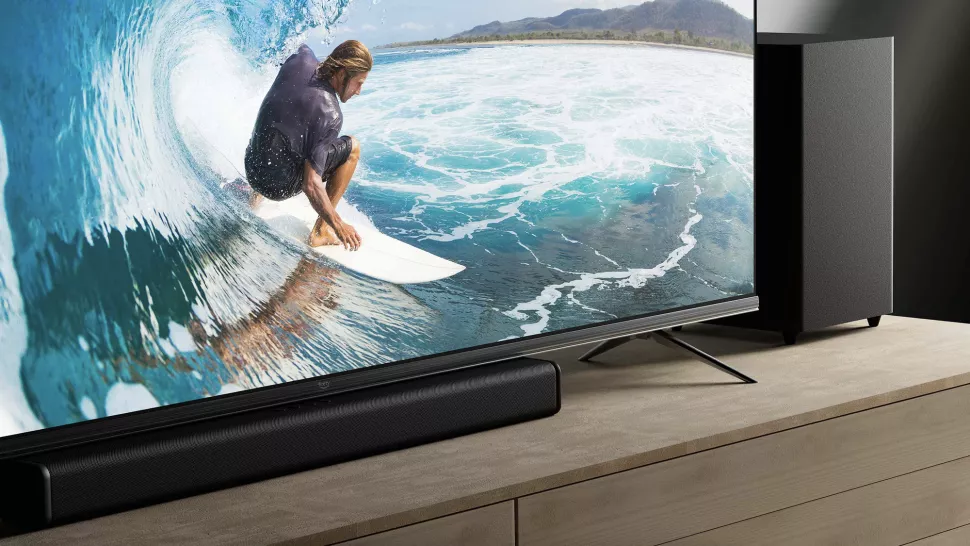
However, if you want fuller, richer sound than the TV’s 8-watt speakers can deliver, you should invest in one of the best soundbars. The Omni’s built-in speakers are adequate but not exceptional.
Review of the Amazon Fire TV Omni: Smart Features
When compared to other low-cost smart TV platforms, Amazon Fire TV is one of the most intelligent. That starts with Alexa built-in, which includes far-field microphones in the TV that listen to the room in the same way an Amazon Alexa speaker does.
If the thought of your TV listening in on al
l of your chats sets off your privacy alarm, you can disable the microphones with a physical switch. However, that isn’t the only way to experience voice control, as the remote includes a built-in microphone with simple press-to-talk access to Alexa.

During our testing, Alexa was swift and responsive, whether I used the room-listening mics or the mic-enabled remote control. Finding and playing content was simple, with the ability to search for shows by title or genre, or to search for anything done by a specific actor or director.
Basic TV functions, such as power and volume control, as well as turning on closed captions or accessing specific programs, were all seamless and performed without the obnoxious repetition that afflicted many voice interaction capabilities in the past. With all of the refinements that Amazon has made to Alexa over the years, the Omni has one of the most usable voice control capabilities that I’ve tested.
Alexa’s growing collection of skills and smart home features is particularly amazing. With spoken commands, you can control a large number of smart home devices, and you can use the TV’s inbuilt IR blaster to control non-smart devices such as Blu-ray players and cable boxes.
Future smart features will include Zoom calling when a compatible USB camera is put in. The Alexa Shortcut Panel, which will let you select common Alexa skills using the directional pad on the remote rather than voice command, and Alexa Home Theater, which will enable Echo speakers to pair wirelessly through the Alexa app to create a multi-channel surround sound setup, are two more features that have been promised. (However, it’s worth noting that these are upcoming smart features that we weren’t able to test during our study; we’ll return to them when the occasion arises.)
The newly redesigned Amazon Fire TV interface is a little cleaner and easier to use than before. With many rows of content suggestions sorted by frequently used applications, free and premium content recommendations, including movies and series on Amazon-owned services like Prime Video and IMDb TV, there’s something for everyone. However, it accomplishes so without relegating other programs and services to the menu’s lower (and less visible) levels, instead focusing on what the user wants to see from their favorite apps. Amazon retains a prominent position in the mix, but it is better tuned in to the realities of users who may have several streaming subscriptions. Overall, the UI is better, and it delivers a lot more than prior versions of Fire TV did.
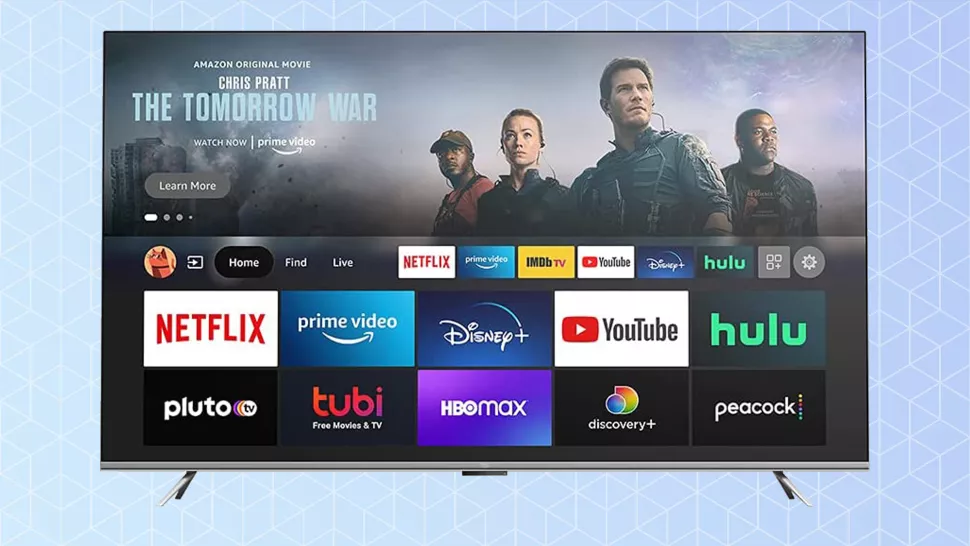
The app store has also been considerably improved, with additional highlights appearing right away, such as free and paid streaming services, sports applications, cable replacement services, new releases, and Alexa-enabled services. It also includes a tiny list of suggested games for those few folks who are interested in playing games on their smart TV.
Aside from those highlights, the app browsing experience has improved significantly, with a tile-based layout that includes small thumbnail photos to give you an idea of what the app is about. It’s not perfect, and the app selection still contains a disproportionate number of low-quality apps with dubious value, but locating what you’re looking for should be easier than ever before.
Amazon Fire TV Omni Review: Remote Control
Anyone who has used a Fire TV product previously will know the remote that comes with the Fire TV Omni, which features a ring-shaped directional pad, some basic media control buttons, volume control, and a few extra buttons that aren’t available on the remotes of Fire TV devices like the Cube.
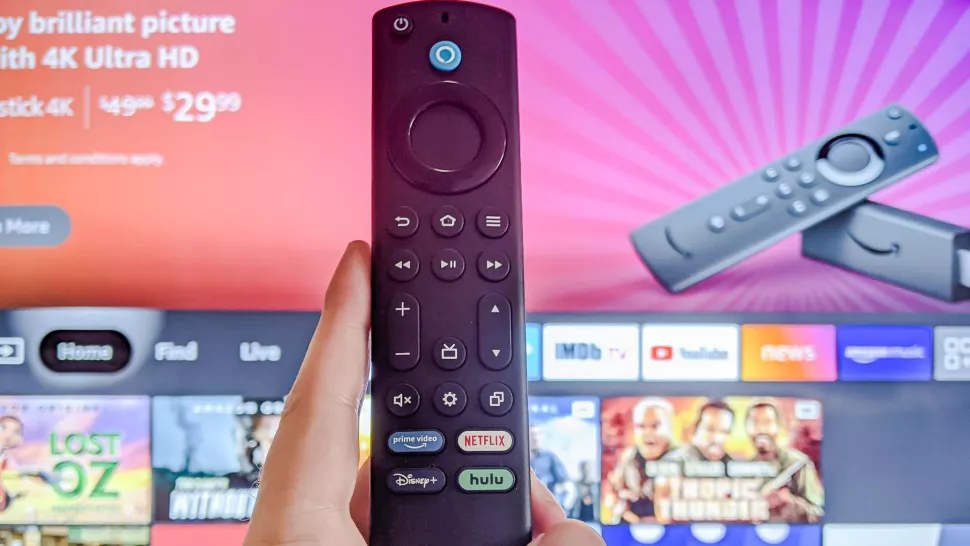
Volume control is complemented by channel up and down buttons, as well as a live TV button that directs you to your antenna or cable channel guide. There are other buttons for muting the music, navigating the settings menus, and viewing a picture-in-picture. The remote contains four dedicated app buttons for Amazon Prime Video, Netflix, Disney Plus, and Hulu.
If you’re not using the TV’s built-in far-field mics, a dedicated button on top lets you activate Alexa and speak directly into the mic-enabled remote control.
Amazon Fire TV Omni review: Verdict
The Amazon Fire TV Omni is clearly a drive to provide a more premium Fire TV experience, from the enhanced design to the inclusion of currently-exclusive features, such as hands-free Alexa, and the promise of being the first to roll out new services, such as video conferencing. This is Amazon’s first Fire TV to be designed in-house and to bear the Amazon logo, so it makes sense. It’s also the most expensive Fire TV to date.
However, the more luxurious appearance and updated interface collide with the hardware’s reality. The more expensive Fire TV Omni doesn’t give a better experience when it comes to watching TV and movies, thanks to its mediocre display and speakers. Instead, it’s a better version of what came before, a fantastic platform for Alexa enthusiasts and Amazon Prime Video aficionados, but a smart TV experience that still lags behind other less expensive options.
Other smart TVs at this price point have a superior picture, thanks to QLED screens and backlights with local dimming. Although the editor’s choice TCL 6-Series Roku TV comfortably outperforms it, the TCL 5-Series Roku TV (S535) offers superior value at a lower price. The Omni isn’t even the greatest Fire TV on the market, which is a shame. Although the Toshiba C350 Fire TV lacks room-listening mics for Alexa, it offers greater picture quality than the Omni while still offering all of the other Fire TV benefits.
The Amazon Fire TV Omni is a nice, but not amazing, television. It will sell well thanks to intensive promotion from Amazon and Best Buy, presumably with huge sales reductions this holiday season, and it will put the first Amazon-made smart TV into households around the world. However, if Amazon genuinely desires a standout smart TV to showcase Fire TV and all of its capabilities, I hope the next generation Omni is better than this one.





